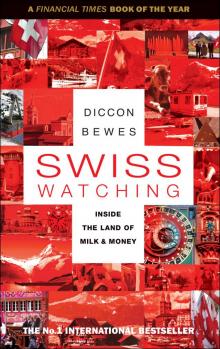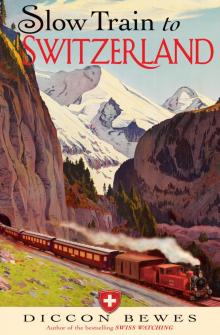- Home
- Diccon Bewes
Swiss Watching Page 30
Swiss Watching Read online
Page 30
HOW SWISS IS HEIDI?
Many months before Herr Hildebrand fell on his sword, there was another revelation that had shocked the nation: Heidi is German! She might be the personification of Switzerland, but the original Swiss miss may not be quite as Swiss as we all thought. It’s almost tantamount to blasphemy to suggest such a thing, but it’s a question that made front-page news in her homeland: one paper had the headline ‘Unser Heidi hat einen deutschen Vater!’ or ‘Our Heidi has a German father’. Notice the ‘our’ – the Swiss are very possessive of their heroine, so you can imagine how much it niggles to have her parentage questioned. It’s on a par with saying that Robin Hood was French, or Tom Sawyer Canadian. So how could such a thing happen?
A German Studies scholar found a story about a little girl who lives with her grandfather, gets sent away to a foreign land, suffers terrible homesickness, but lives happily ever after once she is back in the mountains. And her name was... Adelaide (which can also be written as Adelheid, often shortened to Heidi). This version was written by a German author, Hermann Adam von Kamp, in 1830, half a century before Johanna Spyri wrote her Heidi, the one we know and love. Did Johanna plagiarise a forgotten work? It was an outrage up there with suggesting that Shakespeare copied Marlowe, and the penknives came out immediately.
The scholar behind the discovery was cast as Switzerland’s public enemy no. 1, but remained adamant that Heidi was a second-hand version of a German original. She might have had a Swiss mother, but her father was clearly Herr von Kamp. This is possibly an argument that will never end as, with both authors long since dead, there’s no one to ask. Maybe it’s just a matter of faith, like believing that Jesus never had children. And when it comes to belief in their own country and its icons, the Swiss are second to none.
Swiss national pride and self-confidence have certainly been on the up in the past few years (banking traumas aside), with some British politicians even saying that the UK should be more like Switzerland. They were obviously thinking about the Swiss relationship with the EU, rather than abandoning nuclear weapons, reducing taxes, improving public transport and giving far more power to the people. But perhaps Britain should become more like Switzerland, albeit a version with mushy peas and proper queues. The Alpine republic is by no means a perfect country; it can sometimes feel like an exclusive club where outsiders are reluctantly welcomed and rules are forever set in stone. But its virtues – the scenery, the quality of life, the sense of community – more than outweigh its faults. There is no paradise on earth, but the land of milk and money comes close.
APPENDIX
Switzerland and its 26 cantons in alphabetical order:
Switzerland
Standard abbreviation: CH
Capital: Bern
Population: 7,870,100
Religion:
Languages:
Aargau
Standard abbreviation: AG
Capital: Aarau
Population: 611,466
Religion: Languages:
Appenzell Ausserrhoden
Standard abbreviation: AR
Capital: Herisau
Population: 53,107
Religion: Languages:
Appenzell Innerrhoden
Standard abbreviation: AI
Capital: Appenzell
Population: 15,688
Religion:
Languages:
Date of foundation: 1291
Area: 41,285 km2
Foreigners: 22.4%
Catholic 41.8%
Protestant 35.3%
Muslim 5.7%
German 63.7%
French 20.4%
Italian 6.5%
Romansh 0.5%
Date of entry: 1803
Area: 1404 km2
Foreigners: 21.5%
Catholic and Protestant
German 87.1%
Italian 3.3%
Date of entry: 1513*
Area: 243 km2
Foreigners: 13.9%
Protestant
German 91.2%
Serbo-Croatian 2.3%
Date of entry: 1513*
Area: 172 km2
Foreigners: 10%
Catholic
German 92.9%
Serbo-Croatian 2.5%
*The two half-cantons of Appenzell split in 1597
Basel-Land
Standard abbreviation: BL
Capital: Liestal
Population: 274,404
Religion: Languages:
Basel-Stadt
Standard abbreviation: BS
Capital: Basel
Population: 184,950
Religion: Languages:
*The two half-cantons of Basel split in 1833
Bern
Standard abbreviation: BE
Capital: Bern
Population: 979,802
Religion: Languages:
Fribourg
Standard abbreviation: FR
Capital: Fribourg
Population: 278,493
Religion:
Languages:
Geneva
Standard abbreviation: GE
Capital: Geneva
Population: 457,715
Religion: Languages:
Date of entry: 1501*
Area: 517 km2
Foreigners: 18.9%
Protestant
German 87.2%
Italian 3.5%
Date of entry: 1501*
Area: 37 km2
Foreigners: 31.5%
Protestant German 79.3%
Italian 5.0%
Date of entry: 1353
Area: 5959 km2
Foreigners: 13%
Protestant
German 84.0%
French 7.6%
Date of entry: 1481
Area: 1671 km2
Foreigners: 17.7%
Catholic
French 63.2%
German 29.2%
Date of entry: 1815
Area: 282 km2
Foreigners: 38.7%
Protestant
French 75.8%
English 3.9%
Glarus
Standard abbreviation: GL
Capital: Glarus
Population: 38,608
Religion:
Languages:
GraubĂnden
Standard abbreviation: GR
Capital: Chur
Population: 192,621
Religion:
Languages:
Jura
Standard abbreviation: JU
Capital: Delémont
Population: 70,032
Religion:
Languages:
Lucerne
Standard abbreviation: LU
Capital: Lucerne
Population: 377,610
Religion:
Languages:
Neuchâtel
Standard abbreviation: NE
Capital: Neuchátel
Population: 172,085
Religion:
Languages:
Date of entry: 1352
Area: 685 km2
Foreigners: 19.8%
Protestant
German 85.8%
Italian 4.4%
Date of entry: 1803
Area: 7105 km2
Foreigners: 16.1%
Catholic and Protestant
German 68.3%
Romansh 14.5%
Italian 10.2%
Date of entry: 1979
Area: 838 km2
Foreigners: 12.3%
Catholic
French 90.0%
German 4.4%
Date of entry: 1332
Area: 1493 km2
Foreigners: 16.4%
Catholic
German 88.9%
Serbo-Croatian 2.1%
Date of entry: 1815
Area: 803 km2
Foreigners: 23.1%
Protestant
French 85.3%
German 4.1%
Nidwalden
Standard abbreviation: NW
Capital: Stans
Population: 41,024
Religion:
Languages:
Obwalden
Standard abbreviation: OW
Capital: Sarnen
Population: 35,585
Religion:
Languages:
*The two half-cantons (together known as Unterwalden) have always been separate
Schaffhausen
Standard abbreviation: SH
Capital: Schaffhausen
Population: 76,536
Religion:
Languages:
Schwyz
Standard abbreviation: SZ
Capital: Schwyz
Population: 146,730
Religion:
Languages:
Solothurn
Standard abbreviation: SO
Capital: Solothurn
Population: 255,284
Religion:
Languages:
Date of entry: 1291*
Area: 276 km2
Foreigners: 10.7%
Catholic
German 92.5%
Italian 1.4%
Date of entry: 1291*
Area: 490 km2
Foreigners: 12.9%
Catholic
German 92.3%
Albanian 1.4%
Date of entry: 1501
Area: 298 km2
Foreigners: 22.9%
Protestant
German 87.6%
Italian 2.6%
Date of entry: 1291
Area: 908 km2
Foreigners: 18%
Catholic
German 89.9%
Serbo-Croatian 2.1%
Date of entry: 1481
Area: 791 km2
Foreigners: 19.3%
Catholic
German 88.3%
Italian 3.1%
St Gallen
Standard abbreviation: SG
Capital: St Gallen
Population: 478,907
Religion:
Languages:
Thurgau
Standard abbreviation: TG
Capital: Frauenfeld
Population: 248,444
Religion:
Languages:
Ticino
Standard abbreviation: TI
Capital: Bellinzona
Population: 333,753
Religion:
Languages:
Uri
Standard abbreviation: UR
Capital: Altdorf
Population: 35,422
Religion:
Languages:
Valais
Standard abbreviation: VS
Capital: Sion
Population: 312,684
Religion:
Languages:
Date of entry: 1803
Area: 2026 km2
Foreigners: 21.7%
Catholic
German 88.0%
Serbo-Croatian 2.5%
Date of entry: 1803
Area: 991 km2
Foreigners: 21%
Protestant
German 88.5%
Italian 2.8%
Date of entry: 1803
Area: 2812 km2
Foreigners: 25.4%
Catholic
Italian 83.1%
German 8.3%
Date of entry: 1291
Area: 1077 km2
Foreigners: 9.4%
Catholic
German 93.5%
Serbo-Croatian 1.9%
Date of entry: 1815
Area: 5224 km2
Foreigners: 20.4%
Catholic
French 62.8%
German 28.4%
Vaud
Standard abbreviation: VD
Capital: Lausanne
Population: 713,281
Religion:
Languages:
Zug
Standard abbreviation: ZG
Capital: Zug
Population: 113,105
Religion:
Languages:
Zurich
Standard abbreviation: ZH
Capital: Zurich
Population: 1,373,068
Religion:
Languages:
Date of entry: 1803
Area: 3212 km2
Foreigners: 30.5%
Protestant
French 81.8%
German 4.7%
Date of entry: 1352
Area: 239 km2
Foreigners: 23.3%
Catholic
German 85.1%
Serbo-Croatian 2.7%
Date of entry: 1351
Area: 1729 km2
Foreigners: 23.7%
Protestant German 83.4%
Italian 4.0%
All data from Statistik Schweiz, 2012: Population and Foreigners, 2010; Religion and Languages, 2000.
NOTES
Chapter One: The landlocked island
1 German-speaking Swiss; Italian and French speakers manage more than just a name.
2 English used to have you and thou, which roughly correlated to Sie/vous and du/tu.
3 Saline de Bex: Salzmonopol.
4 Statistik Schweiz: German 63.7% of the population, French 20.4%, Italian 6.5% and Romansh 0.5%.
5 Liechtenstein also shares a short border with Switzerland and is not an EU member.
6 swissinfo.org: Facts and Figures.
7 The top three are Great Britain, Iceland and Ireland.
8 In 1999.
9 blick.ch report, 9.8.2009.
10 Also known as Monte Rosa, the mountain is shared between Italy and Switzerland.
11 Dufour Peak is 4634m, Ascona 193m above sea level.
12 glacierexpress.ch.
13 Ibid.
14 meteoschweiz.ch.
15 Swiss Federal Office of Energy.
16 meteoschweiz.ch. Highest in Grono (GR) on 11.8.2003; lowest in La Brévine (NE) on 12.1.1987.
17 meteoschweiz.ch.
18 In German, Romandie is known as Westschweiz or Welschland.
19 swissinfo.org.
20 ONS: 440 people per square kilometre.
21 CIA World Factbook: 395 people per square kilometre.
22 Statistik Schweiz: Sprachen.
23 Ibid.
24 bloomberg,com article, March 2007.
25 In 1803.
26 For a complete list see the appendix.
27 Mercer Quality of Living Survey 2011: Zurich 2nd, Geneva 8th, Bern 9th.
Chapter Two: Stepping back through time
1 Weg der Schweiz.
2 Ibid.
3 swissworld.org: National Day.
4 swisshiking.ch: Wanderwegnetz.
5 Ibid.: road total 71,300km.
6 BBC Sport.
7 schweizergarde.org.
8 Ibid.
9 swissworld.org.
10 Coop Zeitung Nr 28, 7.7.2004.
11 swissinfo.ch report, 26.7.2004.
12 perrier.com.
13 swissworld.org.
Chapter Three: In the land of cocks and crosses
1 feiertagskalender.ch.
2 foodreference.com.
3 Statistik Schweiz: Wahlen 2011.
4 The Ecologist online article, 30.6.2009.
5 PET-Recycling Schweiz.
6 BBC News, 21.4.2009.
7 petcore.org: Recycled products.
8 Mercer Cost of Living Survey 2011.
9 Statistik Schweiz: Wohnbevölkerung nach Religion 2000.
10 Religionslandschaft in der Schweiz report 2004.
11 Ibid.
12 Ibid.
13 Ibid.
14 Pew Forum.
15 Religionslandschaft in der Schweiz report 2004.
16 NZZ online.
17 Kanton Bern Staatskanzlei: Kirchensteuergesetz, Art 11.2.
Chapter Four: Ask the audience
1 Except when it clashes with Easter; then it moves a week.
2 Appenzell Innerrhoden
official website.
3 NZZ Online report, 26.4.2009.
4 Appenzell Innerrhoden official website.
5 Schweizerische Bundeskanzlei: Volksinitiativen.
6 Switzerland’s Official Web Portal.
7 Kanton Bern Staatskanzlei.
8 Chancellerie d’Etat du canton de Fribourg.
9 Kanton Aargau Wahlbüro.
10 20 full votes plus 6 half-votes makes a total of 23, so a majority has to be 12.
11 swissworld.org.
12 Statistik Schweiz, 1 January 2012.
13 In 2010 the SVP launched a popular initiative to change Bundesrat elections to a popular vote. If enough signatures are collected, the proposal will be voted on in a referendum.
14 NZZ Online report, 13.12.2007.
15 Das Schweizer Parlament website.
16 Times Online report 2.5.2007, quoting from Quirkology by Richard Wiseman.
17 Credit Suisse Worry Barometer 2011.
18 Bundesamt für Statistik.
19 swissworld.org.
20 Bundesamt für Migration.
21 UK Border Agency.
22 escotoday.com.
23 23%, Statistik Schweiz, Erwerbstätige Nationalität 2011.
24 Front page story in The Independent on 7.9.2007.
25 Statistik Schweiz: Wahlen 2007.
26 Schweizerische Bundeskanzlei: Volksabstimmung 29.11.2009, 57.5% and 22.5 cantons yes.
27 Religionslandschaft in der Schweiz report 2004.
28 Of the then 7.5 million inhabitants, only 4.9 million were entitled to vote; fewer than half did, and of those, only three in ten voted for the SVP, i.e. roughly 700,000 people.
29 Schweizerische Bundeskanzlei, Volksabstimmung 5.6.2005, 58.0% yes.
30 Gettysburg Address, 19.11.1863.
31 Schweizerische Bundeskanzlei: Nationalratswahlen 2011.

 Swiss Watching
Swiss Watching Slow Train to Switzerland
Slow Train to Switzerland